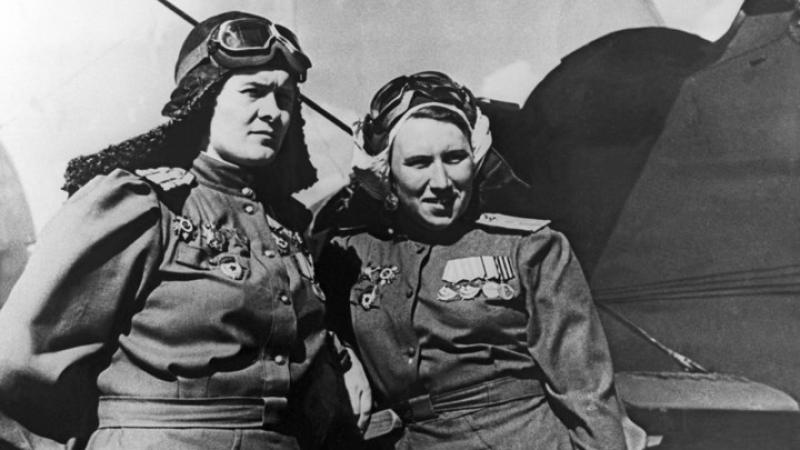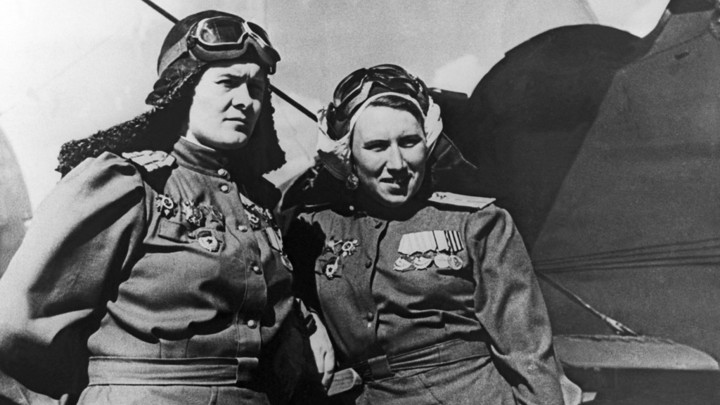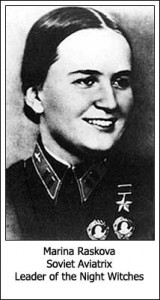Night Witches: The Female Fighter Pilots of World War II


Members of the 588th Night Bomber Regiment decorated their planes with flowers ... and dropped 23,000 tons of bombs.
MEGAN GARBERJUL 15, 2013
 TASS / GETTY
TASS / GETTY It was the spring of 1943, at the height of World War II. Two pilots, members of the Soviet Air Force, were flying their planes — Polikarpov Po-2 biplanes, built mainly of plywood and canvas—over a Soviet railway junction. Their passage was on its way to being a routine patrol ... until the pilots found themselves confronted by a collection of German bombers. Forty-two of them.
The pilots did what anyone piloting a plane made of plywood would do when confronted with enemy craft and enemy fire: they ducked. They sent their planes into dives, returning fire directly into the center of the German formation. The tiny planes' flimsiness was in some ways an asset: their maximum speed was lower than the stall speed of the Nazi planes, meaning that the pilots could maneuver their craft with much more agility than their attackers. The outnumbered Soviets downed two Nazi planes before one of their own lost its wing to enemy fire. The pilot bailed out, landing, finally, in a field.
The people on the ground, who had witnessed the skirmish, rushed over to help the stranded pilot. They offered alcohol. But the offer was refused. As the pilot would later recall, "Nobody could understand why the brave lad who had taken on a Nazi squadron wouldn't drink vodka.
The brave lad had refused the vodka, it turned out, because the brave lad was not a lad at all. It was Tamara Pamyatnykh , one of the members of the 588th Night Bomber Regiment of the Soviet Air Forces. The 588th was the most highly decorated female unit in that force, flying 30,000 missions over the course of four years—and dropping, in total, 23,000 tons of bombs on invading German armies. Its members, who ranged in age from 17 to 26 , flew primarily at night, making do with planes that were—per their plywood-and-canvas construction—generally reserved for training and crop-dusting. They often operated in stealth mode, idling their engines as they neared their targets and then gliding their way to their bomb release points. As a result, their planes made little more than soft "whooshing" noises as they flew by.
Those noises reminded the Germans, apparently, of the sound of a witch's broomstick. So the Nazis began calling the female fighter pilots Nachthexen : "night witches." They were loathed. And they were feared. Any German pilot who downed a "witch" was automatically awarded an Iron Cross .
The Night Witches were largely unique among the female combatants -- and even the female flyers—of World War II. Other countries, the U.S. among them, may have allowed women to fly as members of their early air forces; those women, however, served largely in support and transport roles. The Soviet Union was the first nation to allow women to fly combat missions —to be able, essentially, to return fire when it was delivered. These ladies flew planes; they also dropped bombs.
Last week, one of the most famous of the Night Witches—Nadezhda Popova, a commander of the squad who flew, in total, 852 of its missions—passed away. She was 91. And the obituaries that resulted, celebrations of a life and a legacy largely unknown to many of us here in the U.S., serve as a reminder of the great things the female flyers accomplished. Things made even more remarkable considering the limited technology the woman had at their disposal. The Witches (they took the German epithet as a badge of honor) flew only in the dark. Because of the weight of the bombs they carried and the low altitudes at which they flew, they carried no parachutes. They had no radar to navigate their paths through the night skies—only maps and compasses. If hit by tracer bullets , their craft would ignite like the paper planes they resembled . Which was not a small concern: "Almost every time," Popova once recalled , "we had to sail through a wall of enemy fire."
 1943 Russian military photograph of Nadia Popova with her Po2 biplane (via the book Night Witches )
1943 Russian military photograph of Nadia Popova with her Po2 biplane (via the book Night Witches )Their missions were dangerous; they were also, as a secondary challenge, unpleasant. Each night, in general, 40 planes—each crewed by two women, a pilot and a navigator—would fly eight or more more missions. Popova herself once flew 18 in a single night. (The multiple nightly sorties were necessary because the modified crop-dusters were capable of carrying only two bombs at a time .) The women's uniforms were hand-me-downs from male pilots. And their planes had open cockpits, leaving the women's faces to freeze in the chilly night air. "When the wind was strong it would toss the plane," Popova noted . "In winter, when you'd look out to see your target better, you got frostbite, our feet froze in our boots, but we carried on flying.
Once, after a successful flight—which is to say, a flight she survived—Popova counted 42 bullet holes studding her little plane . There were also holes in her map. And in her helmet. "Katya, my dear," the pilot told her navigator, "we will live long."
Despite all this bravado, however, the female fighter pilots initially struggled to earn the respect of their brothers in arms. The Night Bomber Regiment was one of three female fighter pilot units created by Stalin at the urging of Marina Raskova —an aviation celebrity who was, essentially, "the Soviet Amelia Earhart." Raskova trained her recruits as pilots and navigators, and also as members of maintenance and ground crews . She also prepared them for an environment that preferred to treat women as bombshells rather than bombers. One general, male, initially complained about being sent a "a bunch of girlies" instead of soldiers. But the women and their flimsy little crop-dusters and their ill-fitting uniforms and their 23,000 tons of ammunition soon proved him wrong. And they did all that while decorating their planes with flowers and using their navigation pencils as lipcolor.


Tags
Who is online
102 visitors

Amazing pilots....Kudos to these women who were on the front lines of the fight against the Nazi's.
It is a total shame that we couldn't see the value of half of our citizenry back then.
Well said
Thanks
True but women of all ages stepped up and replaced men in heavy industry and manufacturing war necessities.
Participation of women in the work place increased to 37% during the war and never looked back, peaking at 60% a few years ago, currently at 58%
A look inside women’s history and remembering World War II with an original Rosie the Riveter
Yes they did but, it wasn't until the men running those industries realized they weren't going to meet their quota's without them.
They saw the value Galen. They just wouldn't give them military status or let them fly in combat. Check out the WASP pilots. They flew the same aircraft that men did when transporting the planes from the factory to their destinations in combat zones. That included flying the incredibly dangerous route from Nova Scotia to Iceland to England. The real shame is not that they weren't used (they were). The shame is that they didn't get the honors and status that their work deserved.
I wish I could vote that up a hundred times
Me too.
They ended up going, anyway. Not on the front lines, perhaps, but they were at risk in their roles as nurses, support staff, etc. As TTGA pointed out, they flew combat planes across the Atlantic to deliver them to combat pilots, and were at risk on those flights. But their contribution was undervalued.
Good on them
Incredibly brave ladies who did their job very well, but it should be mentioned that the Night Witches were not fighter pilots as such. They were in fact night ground attack and harassment specialists. There were however also all female fighter regiments as well as mixed male and female fighter regiments. Either way, a very excellent article. Thanks for posting it Kavika.
The title isn't quite accurate re the fighters but it's the title and we are not supposed to change the title of an article.
Here is another that's closer to home for us, Doc.
Got it. Thanks.
These women were all the more amazing considering that the majority of the aircraft they flew were slow rickety old biplanes made of wood and fabric. One of their favorite tactics was to cut their engines before starting their attack runs and glide in silently to catch the enemy off guard and achieve total surprise.
Seems the Germans thought that they were really good at what they did. If they shot one down then received the ''Iron Cross''...
That's why they were scary
A shame they couldn't have had a few Black Widows to fly.
Hitler paid for this big ass mistake.
Agreed
There were also several very successful Soviet women who were snipers. I believe one had over a hundred 'kills' in a three week period during the Kiev Campaigns.
Lyudmila Mikhailovna Pavlichenko
309 confirmed kills
the best of the best in her time.
During the nazi invasion, the Russian snipers put themselves on the map. No gender bias.
A bit later I'll be posting a story on the women snipers of the Russian army, bbl.
I will add this too. Is a shame the US didn't train, arm and support Afghan women when we invaded Afghanistan after 911. Let the women have their just revenge on the Taliban. That could have been the beginning of the end for ME religious zealotry.
Interesting thought.
I support it.
Me, too
The Kurdish women of the YPG make up roughly 40% of their fighting force.
Would that 40% explain why the Trump admires Erdogan?
Let's not get into politics and concentrate on these really brave bomber pilots...Thanks.
What wonderful and brave women.....
Dear Friend Nona: Not seen you in too long.
Hope 2019 goes well for you and yours.
Peace and Abundant Blessings Always.
Enoch.
Indeed they were, Nona.